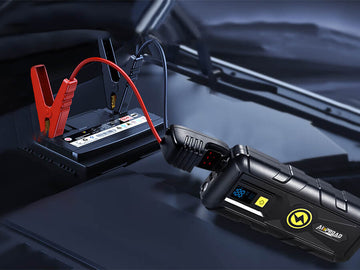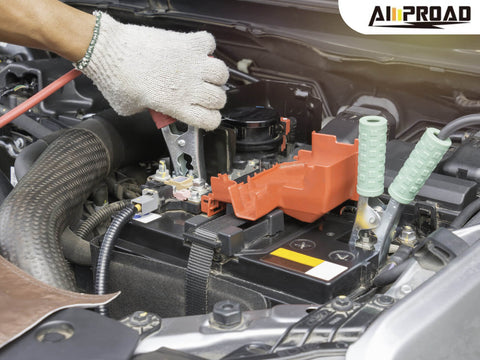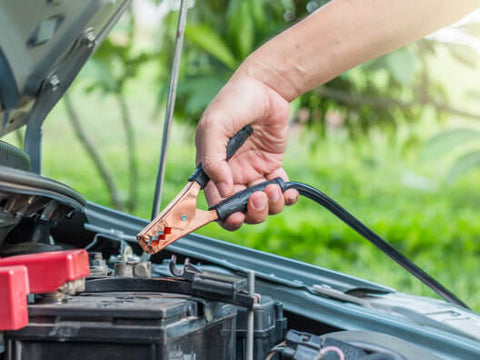
Uh oh! Dead car battery leaving you stranded? Don't worry, a jump start (also called boosting) from another car can get you going again. It's like giving your battery a temporary shot of energy. Here's how it works: a healthy car battery from another vehicle acts as a donor, and its power is transferred through jumper cables to your weak battery. This little boost can be enough to get your car's engine to turn over and hopefully get you back on the road. But before you grab those cables, let's make sure you have the right tools and know the steps to jump start your car safely and effectively.
Essential Tools for Jump Start
Ensuring you have the right tools for jump-starting a vehicle is crucial for a smooth and safe process. Here are some essential tools you'll need:
High-Quality Jumper Cables or Jump Starter:
Invest in high-quality jumper cables or a portable jump starter. Jumper cables should be thick and well-insulated to handle the high current flow safely. Alternatively, a jump starter is a portable battery pack that provides the power needed to jump-start a vehicle without requiring another vehicle. This can be especially useful if you're stranded in a remote location without access to another vehicle for a jump start. Consider a portable jump starter like the AMPROAD iRock 4000A, which can deliver a powerful jump start without needing another car. This is especially useful if you're stranded in a remote location without access to another vehicle for a jump.
Safety Gloves and Glasses:
Protect your hands and eyes by wearing safety gloves and glasses. Battery acid and sparks can pose hazards during jump-starting, so it's essential to take precautions to prevent injuries.
Owner's Manual:
Keep the owner's manual of your vehicle handy. It contains important information about your vehicle's battery location, terminal locations, and any specific jump-starting procedures recommended by the manufacturer.
Clean Cloth or Wire Brush:
Before connecting jumper cables to the battery terminals, ensure they are clean and free of corrosion. Use a clean cloth or wire brush to remove any corrosion from the battery terminals and cable clamps. This ensures a good electrical connection and prevents voltage drop during the jump-start process.
Warning Signs:
Pay attention to warning signs that may indicate a more significant issue with the vehicle's electrical system or battery. These signs include dim headlights, clicking sounds when turning the key, or a dashboard warning light indicating a battery or charging system problem. If you encounter any of these signs, it may be necessary to seek professional assistance rather than attempting a jump start.
Reflective Vest and Warning Triangles:
If you're jump-starting a vehicle on the roadside, it's essential to ensure your safety and visibility to other drivers. Wear a reflective vest and place warning triangles or flares behind your vehicle to alert approaching traffic and reduce the risk of accidents.
By having these essential tools for jump-starting on hand and following proper safety procedures, you can safely and effectively jump-start a vehicle when needed. Remember to always prioritize safety and seek professional assistance if you encounter any issues or uncertainties during the process.
Addressing Battery Corrosion
Battery corrosion can impede the performance of your vehicle's battery and lead to electrical issues. Here's how to identify signs of corrosion and safely address it:
Signs of Battery Corrosion:
One of the most common signs of battery corrosion is the presence of a white, powdery build-up on the battery terminals. This corrosion is typically caused by the chemical reaction between the battery acid and the metal terminals, leading to the formation of sulfate deposits.
Safety Precautions When Dealing with Corrosion:
When dealing with battery corrosion, it's essential to take proper safety precautions. Wear gloves and eye protection to prevent skin irritation and eye injuries from contact with corrosive substances. Additionally, ensure the vehicle's engine is turned off and the ignition key is removed before working on the battery.
Removing Corrosion Using a Baking Soda and Water Solution:
For how to clean car battery corrosion, you can use a simple solution of baking soda and water. Here's how:
Prepare the Solution: Mix one to two tablespoons of baking soda with enough water to form a paste-like consistency.
- Disconnect the Battery Cables: Start by disconnecting the negative (black) battery cable first, followed by the positive (red) cable. This prevents accidental electrical contact while cleaning the terminals.
- Apply the Solution: Use a small brush or toothbrush to apply the baking soda solution to the corroded areas on the battery terminals. Gently scrub the terminals to loosen and remove the corrosion deposits.
- Rinse with Water: After scrubbing, rinse the battery terminals thoroughly with clean water to remove any remaining baking soda residue and corrosion.
- Dry and Reconnect: Once the terminals are clean, dry them with a clean cloth or paper towel. Reconnect the battery cables, starting with the positive (red) cable followed by the negative (black) cable. Ensure the connections are tight and secure.
Note: While cleaning battery corrosion with a baking soda solution can be effective, it's considered an optional step if time allows. In situations where immediate jump-starting is necessary, you can skip this step and proceed with jump-starting the vehicle. However, regular maintenance and cleaning of battery terminals can help prevent corrosion buildup and prolong the life of your vehicle's battery.
How to Boost a Car to Avoid Technical Jargon
Jump-starting a car can be a straightforward process if done correctly. Here's a step-by-step guide to jump-starting a car without using technical jargon:
Park Both Vehicles Close Enough:
Position both vehicles close enough to each other so that the jumper cables can reach both battery terminals without being stretched.
Ensure Both Vehicles Are Turned Off:
Turn off the engines of both vehicles and engage the parking brakes to prevent any movement during the jump-starting process.
Connect the Cables in the Correct Order:
- Red Clamp from Donor Car to Positive Terminal:
Attach the red clamp from the jumper cable to the positive terminal of the dead battery. The positive terminal is typically marked with a "+" sign and may be covered with a red plastic cap.
- Black Clamp from Donor Car to Ground Point:
Connect the black clamp from the jumper cable to a solid metal ground point in the engine bay of the dead car. Choose a clean, unpainted metal surface away from the battery and engine components to avoid sparks.
Connect Remaining Black Clamp to Negative Terminal:
Attach the remaining black clamp from the jumper cable to the negative terminal of the dead battery. The negative terminal is usually marked with a "-" sign and may be covered with a black plastic cap.
Start the Donor Car
Start the engine of the donor car and let it run for a few minutes. This allows the battery to transfer charge to the dead battery and build up sufficient power for starting.
Attempt to Start the Car with the Dead Battery
Once the donor car has been running for a few minutes, attempt to start the car with the dead battery. Turn the ignition key and start the engine. If the engine starts successfully, allow it to run for a few minutes to ensure the battery is fully charged.
Disconnect the Cables in Reverse Order
After the dead car has been successfully started, it's essential to disconnect the jumper cables in the reverse order of connection to prevent electrical hazards:
- Remove the black clamp from the negative terminal of the previously dead battery.
- Remove the black clamp from the solid metal ground point in the engine bay of the dead car.
- Lastly, remove the red clamp from the positive terminal of the dead battery.
Now that you’ve mastered how to boost a car properly by following these simple steps without using technical jargon, you can safely and effectively jump-start a car and get back on the road in no time. Remember to exercise caution and follow safety procedures throughout the jump-starting process.
Addressing Dead Car Batteries Safely and Effectively
Jump-starting a car can provide a quick solution to get your vehicle back on the road, but it's essential to remember that it's only a temporary fix. While jump-starting can revive a dead battery, it does not address the underlying issue that caused the battery to fail in the first place.
After jump-starting your car, it's highly recommended to take your vehicle to a mechanic to have the battery checked and diagnose the root cause of the dead battery. A mechanic can perform a thorough inspection of the battery, charging system, and electrical components to identify any issues that may have led to the battery failure.
By addressing the underlying cause of the dead battery, you can prevent future breakdowns and ensure the reliable operation of your vehicle. Regular maintenance, including battery checks and charging system inspections, can help prolong the life of your car's battery and minimize the risk of unexpected failures on the road.
Remember, while jump-starting can provide a temporary solution, it's important to address the underlying issue to maintain the safety and reliability of your vehicle. So, if you find yourself needing a jump start, don't forget to schedule a visit to your mechanic for a thorough inspection and peace of mind on the road ahead.
FAQs / People Also Ask
Q: What are the essential tools for jump starting a car?
A: Jumper cables! These are insulated cables with clamps on each end, typically red for positive and black for negative. Choose high-quality cables with a thick enough gauge (thickness) to handle the current safely, and long enough to reach both batteries comfortably.
Q: Are there any other tools I should have on hand?
A: While not essential, safety gear is highly recommended. Rubber gloves will protect you from electrical shock, and safety glasses can shield your eyes from potential sparks. A flashlight can also be helpful, especially if jump starting at night or in low-light conditions.
Q: I noticed a white, powdery build-up on my car battery terminals. Should I clean it before jump starting?
A: This is likely corrosion, and while cleaning it isn't mandatory for jump starting, it's a good idea if you have time. A baking soda and water solution can help remove the corrosion. Always wear gloves and eye protection when handling battery corrosion.
Q: Can I use a portable jump starter instead of jumper cables?
A: Absolutely! Portable jump starters are essentially compact car booster pack that provides the power needed to jump start a car, eliminating the need for another vehicle. The AMPROAD iRock 4000A is a great example, offering a powerful jump start solution. They're particularly useful if you're stranded without access to another car for a jump.




